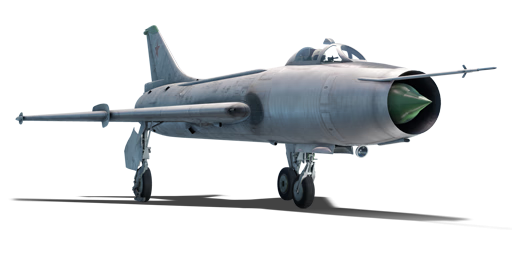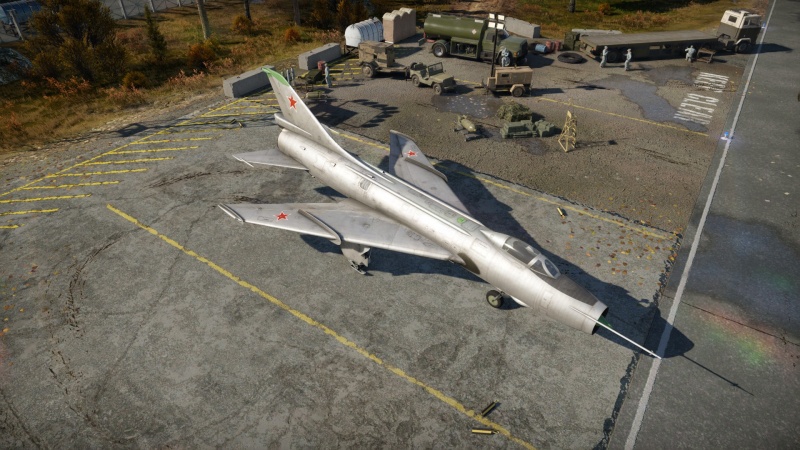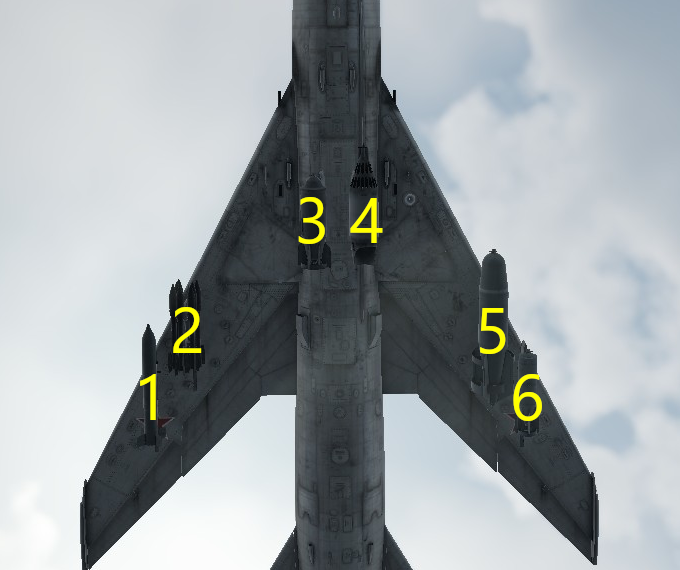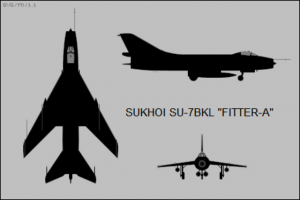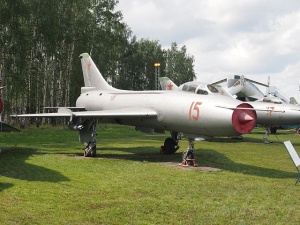Su-7BKL
| This page is about the Soviet strike aircraft Su-7BKL. For other versions, see Su-7 (Family). |
Contents
Description
The Su-7BKL was an upgrade over the Su-7B variant. It required less runway for takeoff and landings in both paved and dirt. The aircraft featured rocket boosters to decrease the amount of time required to takeoff, reducing the distance to 800 m, which was considerably less than the 1,250 m of the Su-7B. It also had an improved landing chute and a stronger rear landing gear. The Su-7BKL was produced in large numbers, with a total of 700 units built, making it the most produced variant of the Su-7 design. It was produced up to 1971 when it was replaced by the Su-17. It also received an export variant, the Su-7BMK, produced until 1965 for countries outside the Warsaw pact.
Introduced in Update "Raining Fire", the Su-7BKL is an excellent fighter bomber thanks to its amazing speed and variety of ground ordnance. With very good acceleration at low speeds, a powerful engine, and good top speed, it is often one of the first to reach the battlefield. It has enough ordnance to destroy a full base without affecting its flight performance too much, using 4 x ZB-360 bombs. It also has a ballistic computer for rockets, so in ground Realistic battles it can use the S-24 rockets to destroy any ground target with a single precise shot. However, the Su-7BKL, while very good, suffers from lack of air-to-air missiles or countermeasures, so it has no way to avoid common missiles like the AIM-9G, AIM-9L, or R-60, except for executing very precise evasive manoeuvres. Thus, staying fast and out of the range of planes carrying those weapons is something very important to keep in mind.
General info
Flight performance
The Su-7BKL has the same flight performance as the Su-7B, with excellent acceleration and climb rate, along with decent manoeuvrability. The biggest advantage of the Su-7BKL is its acceleration and top speed, with a TWR above 0.8 across most flight regimes and fuel loads. This means that the Su-7BKL out-accelerates almost every aircraft at its BR, with the exception of Harriers at lower speeds. Top speed is just over Mach 1 at lower altitude, making the Su-7BKL faster than most aircraft it faces. Given its powerful engine, the Su-7BKL has an extremely impressive climb rate of almost 200 m/s. Given its acceleration, top speed and climb rate, few aircraft can keep up with the Su-7BKL in straight-line dashes.
The Su-7BKL's manoeuvrability performance is not as impressive. Its sustained turn rate at low speeds is competitive, but instantaneous turn rate and maximum angle-of-attack are both relatively low compared to its adversaries. This may make it more difficult to get guns on target. Additionally, some yaw instability occurs at medium speeds when pulling high-G turns. Finally, note that the Su-7BKL can break its wings in turns exceeding 9 G's, though this G-number isn't obtainable unless the aircraft is clean and carrying less than 20 minutes of fuel.
| Characteristics | Max Speed (km/h at 11,000 m) |
Max altitude (metres) |
Turn time (seconds) |
Rate of climb (metres/second) |
Take-off run (metres) | |||
|---|---|---|---|---|---|---|---|---|
| AB | RB | AB | RB | AB | RB | |||
| Stock | 2,166 | 2,151 | 19000 | 27.5 | 28.5 | 168.0 | 159.6 | 1,250 |
| Upgraded | 2,323 | 2,232 | 26.6 | 27.0 | 225.2 | 195.0 | ||
Details
| Features | |||||
|---|---|---|---|---|---|
| Combat flaps | Take-off flaps | Landing flaps | Air brakes | Arrestor gear | Drogue chute |
| X | X | ✓ | ✓ | X | ✓ |
| Limits | ||||||
|---|---|---|---|---|---|---|
| Wings (km/h) | Gear (km/h) | Flaps (km/h) | Max Static G | |||
| Combat | Take-off | Landing | + | - | ||
| 1,260 | 630 | N/A | N/A | 473 | ~10 | ~3 |
| Optimal velocities (km/h) | |||
|---|---|---|---|
| Ailerons | Rudder | Elevators | Radiator |
| < 700 | < 650 | < 600 | N/A |
Engine performance
| Engine | Aircraft mass | |||||
|---|---|---|---|---|---|---|
| Engine name | Number | Basic mass | Wing loading (full fuel) | |||
| Saturn AL-7F-1-250 | 1 | 8,446 kg | 343 kg/m2 | |||
| Engine characteristics | Mass with fuel (no weapons load) | Max Takeoff Weight | ||||
| Weight (each) | Type | 9m fuel | 20m fuel | 30m fuel | ||
| 2,200 kg | Afterburning axial-flow turbojet | 9,411 kg | 10,585 kg | 11,664 kg | 15,010 kg | |
| Maximum engine thrust @ 0 m (RB/SB) | Thrust to weight ratio @ 0 m (WEP) | |||||
| Condition | 100% | WEP | 9m fuel | 20m fuel | 30m fuel | MTOW |
| Stationary | 5,848 kgf | 8,257 kgf | 0.88 | 0.78 | 0.71 | 0.55 |
| Optimal | 6,664 kgf (1,000 km/h) |
9,974 kgf (1,000 km/h) |
1.06 | 0.94 | 0.86 | 0.66 |
Survivability and armour
- The pilot is protected by light aluminium plates and an armoured glass windscreen. These will not stop 20 mm AP frontally, but offer decent protection from the rear.
- The engine is only protected by fuel tanks underneath. These can reduce the damage from shrapnel, but it is otherwise unprotected.
- The flight control's cables go underneath the fuselage, and have a good chance to stay in one piece when hit.
- The aircraft does not come with flares but has RWR. It will struggle against anything higher than its BR.
Modifications and economy
If you aim to play the Su-7BKL in ground battles, the first priority is to unlock the aircraft's anti-ground ordnance. The FAB-500 bombs and S-24 rockets are particularly helpful. Otherwise, focus on flight performance upgrades, starting with compressor, airframe, wings repair and engine. After those upgrades are researched and purchased, the other flight performance upgrades can be researched. The 30 mm ammunition belts can be researched last as the stock ammunition belts are quite potent.
Armaments
| Ballistic Computer | |||
|---|---|---|---|
| CCIP (Guns) | CCIP (Rockets) | CCIP (Bombs) | CCRP (Bombs) |
| |
|
|
|
Offensive armament
The Su-7BKL is armed with:
- 2 x 30 mm NR-30 cannons, wing-mounted (80 rpg = 160 total)
The Su-7BKL comes equipped with 2 x 30 mm NR-30 cannons; these will be familiar to pilots which flew the preceding Su-7B, or the MiG-19PT and MiG-21F-13 in the parallel line. The Su-7 has greater ammunition capacity than earlier MiGs with the gun, 160 rounds giving a trigger time of approximately 4.8 seconds. With velocity ranging from 780-785 m/s depending on the shell, this is much faster than the earlier NR-23 or N-37D found on earlier Soviet jets. This greatly simplifies aiming, and with the 67.14 g of TNTe filler found in the HEF-I and HEFI-T shells, hits from this cannon will usually cripple or destroy enemy aircraft on the first hit. As the Su-7BKL is a strike fighter the guns may also be used against armoured targets; the mix of AP-T with 48 mm penetration and APHE with 37 mm penetration, but 22.48 g TNTe of explosive filler will do significant damage to enemy armour. It is recommended to attack from above, as most enemy tanks have weak roof armour and can be more effectively penetrated from above.
Suspended armament
The Su-7BKL can be outfitted with the following ordnance:
| 1 | 2 | 3 | 4 | 5 | 6 | ||
|---|---|---|---|---|---|---|---|
| 250 kg OFAB-250sv bombs | 1 | 1 | 1 | 1 | 1 | 1 | |
| 500 kg FAB-500M-54 bombs | 1 | 1 | 1 | 1 | |||
| ZB-360 incendiary bombs | 1 | 1 | 1 | 1 | |||
| S-3K rockets | 7 | 7 | 7 | 7 | 7 | 7 | |
| S-5K rockets | 16, 32 | 16 | 16, 32 | 16, 32 | 16 | 16, 32 | |
| S-24 rockets | 1 | 1 | 1 | 1 | 1 | 1 |
| Default weapon presets | |
|---|---|
| |
As a strike aircraft, the Su-7BKL has access to an array of ground-focused armaments, notably lacking air-to-air missiles.
The Su-7BKL gains access to S-5K, S-3K, and S-24 rockets in various quantities. The S-5K is the first rocket pilots will unlock; these are in a rocket pod, and pilots will gain access to pods of 16 or 32 rockets, with loadouts including either 96 or 160 rockets. These rockets are very small with a mass of only 3 kg, and only 150 mm penetration from the charge. Pilots are recommended to use the large quantities of rockets to fire salvos of rockets instead of attempting to destroy targets with a single pair, as these very small rockets are unlikely to reliably do so. The next rocket is the S-3K, these are larger rockets not found in pods, instead being mounted on rails attached to the pylons. These are much more substantial rockets, with a mass of 23 kg and 300 mm penetration. Volley fire may still be preferred as 42 rockets can be mounted, but single hits are more likely to destroy enemy armour than the smaller S-5K. The S-24 is the final rocket the Su-7BKL gains access to, a large rocket weighing 235 kg and with more explosive mass than a 50 kg bomb. This is very effective against enemy armour and is rather accurate as well, allowing pilots to use the rocket CCIP to hit targets from 2-3 km away; enabling pilots to keep their distance from enemy air defense. These rockets can also be used with a distance fuse, allowing it to detonate at a specific distance. This can either be used above the ground to hit soft targets behind cover, or in the air against aircraft, giving the Su-7BKL additional firepower against enemy aircraft. 6 of these rockets are mounted directly on the weapons pylons.
As for bombs, the Su-7BKL gains access to 3 types: 250 kg, 500 kg, and 360 kg incendiary bombs. The incendiary bombs are the first to be unlocked; these work well against open-topped vehicles but do no damage to enclosed compartments. They can be used against concentrations of enemy light targets, as cover or to block areas, as the fire will burn for some time after the bombs have landed. They also work well against bombing targets in Air RB, doing damage over time to the base. The 250 kg bombs are the first conventional bombs unlocked, followed by the 500 kg bombs. The 500 kg bombs can only be carried on the inner 4 pylons, leaving the Su-7BKL with a maximum payload of 4 x 500 and 2 x 250 kg bombs. This will work well in either air or ground forces battles when coupled with the bomb CCIP, especially since the bombs drop individually, allowing for 6 precise drops.
Usage in battles
The Su-7BKL just like its predecessor (Su-7B) has a very good acceleration and can outspeed most jets, it can easily doge incoming missiles by turning as it can turn and still maintain most of its speed (mind the G forces as it can easily break your plane apart and make the pilot lose conscience). The Su-7BKL sports 30 mm NR-30 cannons and can also be equipped with both bombs and rockets for various types of playstyle. The Su-7BKL also comes with a rangefinding radar and the S-24 can be put on a distance fuse to be used in air combat.
Air combat
At the start of a match, take 27 minutes of fuel and equip Air targets belt. Start ascending on a 30-35° angle to an altitude of 7-9 km, your goal is to get behind the enemies in order to easily take care of them without their knowledge of your presence. Keep flying at this altitude and overfly enemy fighters. If there is an enemy at this altitude, feel free to engage into a head-on or dodge them. Keep flying above the enemies until there are none underneath you, turn around and start descending while keeping an eye on your speed. Go for the nearest enemy or slowest (A-10s for example). Get behind them and approach as fast as possible as speed is your greatest advantage. Start firing when you're close enough. If the enemy is eliminated, go for the next one, but if you missed do not engage into a dogfight: maintain your speed and go after the next target. If there are any AI planes, you can safely go after them and make use of your gyro linked gunsight to auto adjust your guns' distance. Align your plane behind the AI plane, put your gunsight's dot on the plane, and shoot a short burst of rounds (it is more precise in the first person view). After having expended your ammunition, you can return back to the base to continue fighting or swap tactics.
Attacking ground targets
At the start of a match, equip the 42 x S-3K rockets or the 160 x S-5K rockets (which will be helpful to take care of light and medium tanks). Start ascending on a 10° angle until above 1 km altitude, you will need the speed to quickly evade enemies and enemy missiles. It's best to flank and fly to the far sides of the map, so you can easily fly in a straight line and take care of ground targets one after the other. When firing at a ground target: any tank except for medium and heavy tanks requires a single hit by both rockets, while medium and heavy tanks would require 2 or more rockets. Always keep a eye on your surroundings as you're flying fast at a low altitude, which can catch the attention of enemy jets who will then try to engage you. Maintaining a high speed is important, in case a missile is fired at you. After depleting all of your rockets, you can head back to base to resupply rockets or start going after enemy players or AI planes.
Bombing bases
At the start of a match, equip the 4 x ZB-360 bombs (as that is enough to take care of a base). And start ascending on a 20° angle to 4-6 km, you might be behind everyone a little bit but the higher top speed and acceleration you will get on this altitude will make up for it (and thanks to the ballistic computer bombing from this high altitude is no issue). Start heading for any enemy base and keep this altitude. Avoid any head-on and beware of enemies below and above you with missiles that might eliminate you. When you're near the base, start diving, enable your airbrakes, and get into position to drop your payload. Once bombs have been dropped, you can head back to base for another bombing run or start going after enemy players, AI planes or ground targets. The choice is yours.
CAS ground
When flying the Su-7BKL, equip the 6 x S-24 rockets (as a single hit from these is enough to take care of any ground target). Start heading to the battle area and keep a high altitude to avoid SPAAs and enemy planes. Once close enough, start diving and search for targets to fire at. If there is a SPAA that starts shooting at you, prioritize it above everything else. If there are no SPAAs, fire a single rocket at a target and go after the next one (even if it misses the target, the rocket will overpressurize them). Once too low, start pulling up and gain altitude again, then repeat this process until you're out of rockets. You can then go to base to resupply or go after enemy planes, soft ground targets or helicopters.
- Enemies worth noting
A-10A / A-10A Late: these American strike aircraft might seem slow but they have access to the mid-range and fast AIM-9L Sidewinder air-to-air missiles which are very accurate. It's almost impossible to dodge them even when flying above Mach 1.1. It's best to keep a distance from the A-10s, as the missiles have an all-aspect tracking and dodging them in a head-on is close to impossible. The best way to defeat the A-10 is from behind, as even from the sides the A-10 can quickly turn around and fire a missile. When coming at it from behind, approach as fast as possible as the A-10 is slow. Speed is your advantage to quickly win the fight if it doesn't respond fast enough. If you miss the attack, quickly turn back around and hope that the A-10 won't fire its missile at you. After a missed interception it's best to leave the A-10 and go after other targets as now the A-10 is aware of your presence, and going for a second interception would be taking an unnecessary risk.
Radars
The Su-7BKL is equipped with a SRD-5 rangefinding radar, located in the nose of the aircraft. It will automatically detect and lock onto planes within the range. It is linked with a gyro gunsight and can help with aiming at close range.
| SRD-5 - Rangefinding radar | |||
|---|---|---|---|
| Maximum Tracking Range |
Minimum Tracking Range |
Azimuth Tracking Angle |
Elevation Tracking Angle |
| 3,000 m | 300 m | ±9° | ±9° |
Pros and cons
Pros:
- Good horizontal flight speed
- Large variety of mounted weapons
- Powerful cannons capable of accurate strafing runs together with the ballistic computer
- Fast climb rate
- Good acceleration
- Has RWR
- The gyro-linked gunsight changes distance automatically up to 1,000 m thanks to rangefinding radar
Cons:
- Mediocre controllability
- Subpar roll rate, even with the boosters modification installed
- No guided weapons
- No flares/chaff
History
The Su-7BKL is a further improvement of the Su-7B fighter bomber. The main goal was to shorten the take-off and landing distances on both paved and dirt airfields, so the aircraft was fitted with rocket boosters to reduce take-off length by 800 metres, and improved landing chutes with enlarged areas to decrease landing distance by 500 metres. Rear landing gear length was reduced and skis were installed to the wheels, in order to make unpaved airfield landings more effective.
The Su-7BKL was the variant of the Su-7 with the largest production. A total of 700 units were built up to 1971 when it was phased out in favour of the Su-17 strike aircraft. The Su-7BKL had used the Lyulka AL-7F-I engine with very good performance, being one of the fastest strike aircraft of its time. That also gave the Su-7BKL a maximum takeoff weight of 13,500 kg. This amazing performance made it suitable for the new lightning strike doctrine of the Soviet Air Force. This included the capability to carry tactical nuclear warheads to be used in case of a war with NATO. Thus, it was made compatible with the 8U69 (244N) tactical nuclear bomb.
The Su-7BKL also had an export variant that saw use in many different nations. This export variant was known as the Su-7BMK and was produced until 1965 for those countries that were aligned with the USSR but did not form part of the Warsaw Pact. Some of those countries were Afghanistan, Vietnam, Egypt, Algeria, India, Iraq, and Yemen. However, the Su-7BMK never saw use in combat with the Soviet Union.
Media
- Skins
See also
Links to the articles on the War Thunder Wiki that you think will be useful for the reader, for example:
- reference to the series of the aircraft;
- links to approximate analogues of other nations and research trees.
External links
| Sukhoi Design Bureau (Сухого Опытное конструкторское бюро) | |
|---|---|
| Jet fighters | Su-9 · Su-11 |
| Su-27 | Su-27 · Su-27SM |
| Strike aircraft | |
| Su-2 | BB-1 · Su-2 (M-82) · Su-2 MV-5 · Su-2 TSS-1 |
| Su-6 | Su-6 · Su-6 (AM-42) · Su-6 (M-71F) |
| Su-7 | Su-7B · Su-7BKL · Su-7BMK |
| Su-8 | Su-8 |
| Su-17 | Su-17M2 · Su-17M4 · Su-22M3 |
| Su-24 | Su-24M |
| Su-25 | Su-25 · Su-25BM · Su-25K · Su-25T · Su-25SM3 · Su-39 |
| Su-34 | Su-34 |
| Export | ◊Su-22UM3K · ◔Su-22M3 · ◊Su-22M4 · ◄Su-22M4 WTD61 |
| J-11* | |
| *CKD and SKD kits assembled by Shenyang Aircraft Corporation | |
| USSR jet aircraft | |
|---|---|
| Bereznyak-Isayev | BI |
| Yakovlev | Yak-15 · Yak-15P · Yak-17 · Yak-23 · Yak-28B · Yak-30D · Yak-38 · Yak-38M · Yak-141 |
| Mikoyan-Gurevich | MiG-9 · MiG-9 (l) · MiG-15 · MiG-15bis · MiG-15bis ISh · MiG-17 · MiG-17AS · MiG-19PT |
| MiG-21F-13 · MiG-21PFM · MiG-21S (R-13-300) · MiG-21SMT · MiG-21bis | |
| MiG-23M · MiG-23ML · MiG-23MLD · MiG-27M · MiG-27K | |
| MiG-29 · MiG-29SMT | |
| Lavochkin | La-174 · La-15 · La-200 |
| Sukhoi | Su-9 · Su-11 |
| Su-7B · Su-7BKL · Su-7BMK · Su-17M2 · Su-17M4 · Su-22M3 | |
| Su-24M | |
| Su-25 · Su-25BM · Su-25K · Su-25T · Su-25SM3 · Su-39 | |
| Su-27 · Su-27SM | |
| Su-34 | |
| Ilyushin | IL-28 · IL-28Sh |
| Tupolev | Tu-14T |


